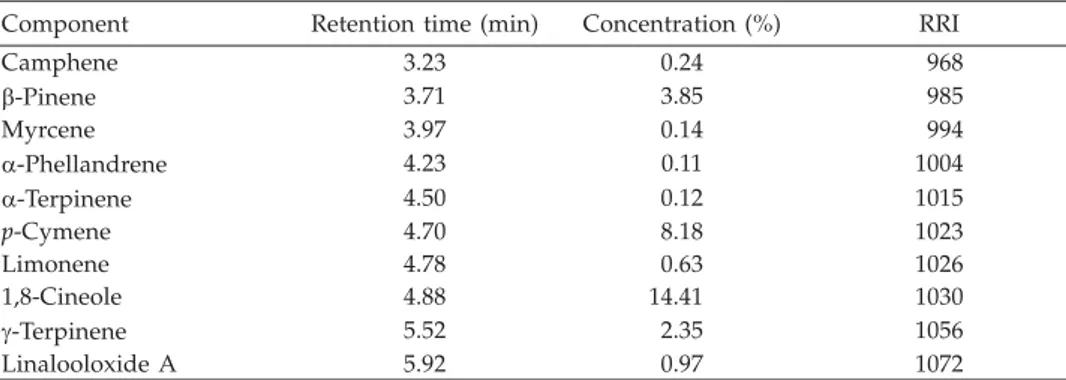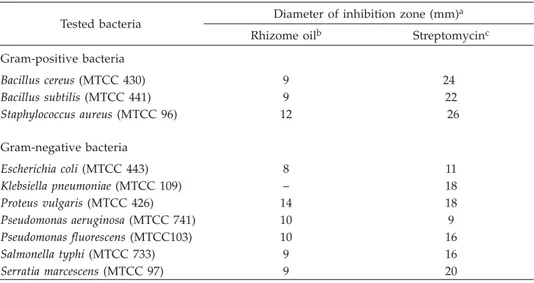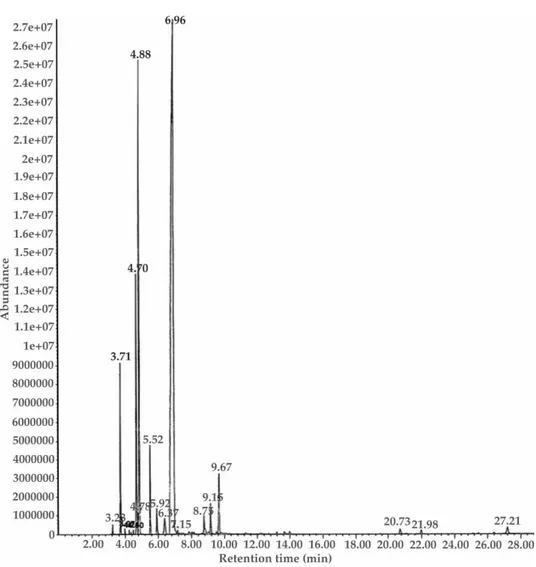The genusHedychiumKoenig (Zingiberaceae) comprises about 80 species distributed from India to south-east Asia (1). Plants of the genusHedychiumare used in perfumery and in ethnomedicine. Aroma concentrate prepared from the flowers ofH. coronariumis used in perfumery. According to ethnobotanical information, the roots ofH. acuminatum is used for diarrhoea, snake bite and liver complaints, while the rhizome ofH. spicatum is used for asthma, bronchitis, blood purification, gastric disorders and as antiemetic. Rhizone ofH. garcileis used for chest pain (2).
Hedychium larseniiM. Dan & Sathish is a rhizomatous herb, with a leafy stem ca 60 cm tall. Inflorescences are ca 13 cm long, dense, cone-like, flowers are white, turning creamy with age and fragrant (3). Since there are no reports on the chemistry and antibacterical activity of the rhizome oil ofH. larsenii, we thought it desirable to undertake the present study. Rhizomes ofH. larsenii, brought from Manipur, India, were under cultivation in the Tropical Botanic Garden and Research Institute (TBGRI), Palode, South India (100 m).
Chemical composition and antibacterial activity of the
rhizome oil of
Hedychium larsenii
GOPANRAJ1 MATHEW DAN1 SUGATHAN SHIBURAJ1
MATHUR GOPALAKRISHNAN SETHURAMAN2 VARUGHESE GEORGE1*
1Tropical Botanic Garden and
Research Institute, Pacha-Palode Thiruvananthapuram-695 562 Kerala, India
2Department of Chemistry
Gandhigram Rural Institute Gandhigram-624 302 Tamil Nadu, India
Received October 21, 2004 Accepted June 28, 2005
The composition of essential oil from the rhizomes of Hedychium larsenii M. Dan & Sathish was examined by GC-FID and GC-MS techniques. 99% of the oil consisted of monoterpenoids. Sesquiterpenoids were present only in negligible quantities. Linalool and 1,8-cineole were identified as the major components. The oil showed mo-derate antibacterial activity against Gram-positive and Gram-negative bacteria.
Keywords: Hedychium larsenii(Zingiberaceae), rhizome, es-sential oil, GC, GC-MS, antibacterial activity
Rhizomes of the plant, harvested from the garden in June 2004, were used for the pres-ent investigation. A voucher specimen No. 54623 is deposited in TBGT.
EXPERIMENTAL
Sample preparation
Fresh rhizomes were cut into small pieces and hydrodistilled using a Clevenger ap-paratus with a water-cooled oil receiver. The oil (yield 0.14%,V/m) was transferred into a stoppered tube, dried over anhydrous sodium sulphate and stored in a refrigerator at 4 °C until analyzed.
GC-FID and GC-MS analyses
GC-FID analysis of the oil was carried out on a Nucon 5765 gas chromatograph (In-dia) fitted with a SE-30 10% Chromosorb-W packed stainless steel column (2 m x 2 mm). Oven programme was: 80–150 °C: 8 °C min–1, 150–230 °C: 5 °C min–1, 230 °C (10 min); carrier gas: nitrogen, flow rate 40 mL min–1; injector temperature 220 °C; detector tem-perature 250 °C. GC-MS analysis of the oil was performed by splitless injection of 1.0mL of the oil on a Hewlett Packard 6890 (USA) gas chromatograph fitted with a cross-linked 5% PH ME siloxane HP-5 MS capillary column (30 m x 0.32 mm, 0.25mm coating thick-ness), coupled with a model 5973 mass detector. GC-MS operation conditions were as follows: injector temperature 220 °C; transfer line 290 °C; oven temperature programme 60–246 °C: 3 °C min–1; carrier gas: helium at 1.4 mL min–1; mass spectra: Electron Impact (EI+) mode: 70 eV, ion source temperature: 250 °C. Individual components were identi-fied by Wiley 275.L database matching and by comparison of retention times and mass spectra of constituents with published data (4). Relative percentage of components was calculated from the peak area-percent report of volatiles from GC-FID data (Table I). Rela-tive retention indices were calculated with reference to the retention times of standard hydrocarbons C5-C30(Aldrich, India) (5).
Table I. Chemical composition of the rhizome oil ofHedychium larsenii
Component Retention time (min) Concentration (%) RRI
Camphene 3.23 0.24 968 b-Pinene 3.71 3.85 985 Myrcene 3.97 0.14 994 a-Phellandrene 4.23 0.11 1004 a-Terpinene 4.50 0.12 1015 p-Cymene 4.70 8.18 1023 Limonene 4.78 0.63 1026 1,8-Cineole 4.88 14.41 1030 g-Terpinene 5.52 2.35 1056 Linalooloxide A 5.92 0.97 1072
Antibacterial analysis
The rhizome oil ofH. larseniiwas tested for antibacterial activity by the disc agar diffusion method (6, 7). Gram-positive and Gram-negative bacterial strains which were obtained from the Institute of Microbial Technology, Chandigarh, India, were used for testing. The bacteria were grown on the Mueller-Hinton agar medium (pH 7.2–7.4). Mi-crobial suspensions were then made from the agar plates using relevant broths. The agar
Component Retention time (min) Concentration (%) RRI
Linalooloxide B 6.37 1.07 1089 Linalool 6.96 62.26 1106 Fenchyl alcohol 7.15 0.17 1110 Borneol 8.75 0.86 1146 Terpinene-4-ol 9.16 1.09 1155 a-Terpineol 9.67 2.48 1166 a-Selinene 20.73 0.31 1466 Selina-3,7 (11)-diene 21.98 0.21 1497 Juniper camphor 27.21 0.49 1700 Total: 99.94
RRI – relative retention index
Table I. continued
Table II. In vitro antibacterial activity of the rhizome oil ofHedychium larsenii
Tested bacteria Diameter of inhibition zone (mm)
a
Rhizome oilb Streptomycinc
Gram-positive bacteria Bacillus cereus(MTCC 430) 9 24 Bacillus subtilis(MTCC 441) 9 22 Staphylococcus aureus(MTCC 96) 12 26 Gram-negative bacteria Escherichia coli(MTCC 443) 8 11 Klebsiella pneumoniae(MTCC 109) – 18 Proteus vulgaris(MTCC 426) 14 18 Pseudomonas aeruginosa(MTCC 741) 10 9 Pseudomonas fluorescens(MTCC103) 10 16 Salmonella typhi(MTCC 733) 9 16 Serratia marcescens(MTCC 97) 9 20
aExperiments were done in triplicate and the results are mean values. bOil dilution, 1:1 in DMSO; 5mL oil per disc.
media were poured into the plates to a uniform depth of 5 mm and allowed to solidify. The microbial suspensions were then streaked over the media surface using a sterile cot-ton swab to ensure confluent growth of the organism. 10mL aliquots of the oil diluated 1:1 with DMSO were impregnated on Whatman No. 1 filter paper discs of 6 mm size. The discs were then aseptically applied to the surface of agar plates at well-spaced inter-vals. The plates were incubated at 36 °C for 24 h and the observed zones of inhibition were measured. Control discs impregnated with 10mL of DMSO, inert solvent, and re-ference substance streptomycin, 2mL of 1 mg mL–1solution, were used alongside the test discs in each experiment (Table II).
RESULTS AND DISCUSSION
Hydrodistillation of fresh rhizomes ofH. larseniiafforded a pleasant-smelling pale yellow oil in 0.14% (V/m) yield. Other physical properties were d20= 0.920,aD20= –5.39°. Table I shows the essential oil components whose percentage was determined by GC--FID and the identity was established by GC-MS, literature data and by relative retention indices.
The GC (Fig. 1) shows nineteen compounds accounting for 99.9% of the oil. 98.9% of the oil consisted of monoterpenes while sesquiterpenes accounted for only 1%. The con-stituents identified consisted of eight monoterpene hydrocarbons (camphene,b-pinene, myrcene,a-phellandrene,a-terpinene,p-cymene, limonene andg-terpinene), one mono-terpene ether (1,8-cineole), seven monomono-terpene alcohols (linalool, linalool oxide A and B, fenchyl alcohol, borneol, terpinene-4-ol and a-terpineol) and three sesquiterpenes [(a--selinene, selina-3,7(11)-diene and juniper camphor)]. 1,8-cineole was identified as the major constituent in some of the previously studiedHedychiumspecies, such asH. spi-catum(27–56%) (8),H. coronarium(47.4%) (9),H. venustum(18%) (9),H. flavescens(50.9%) (9) andH. acuminatum(76%) (10). However, the major constituent inH. larseniiwas iden-tified as linalool (62.3%), 1,8-cineole is the second major constituent (14.4%), followed by p-cymene (8.2%).
The oil was tested against Gram-positive and Gram-negative bacteria. The results presented in Table II show that 10ml of the oil at 1:1 dilution with DMSO is moderately active against most of the tested bacteria as compared to 2mg streptomycin per disc. The oil did not show any activity against the Gram-negative bacteriumKlebsiella pneumoniae, but activity comparable to that of streptomycin againstPseudomonas aeruginosa was observed.
CONCLUSION
The study has helped in identifyingH. larsenii, a hitherto uninvestigated aromatic plant, as a new natural source of linalool (62%). Preliminary antibacterial studies have shown that the oil has modest activity against Gram-positive and Gram-negative bacteria.
Acknowledgements.– The authors express their sincere thanks to Dr. G. M. Nair, Director, TBGRI, for providing laboratory facilities, and the Director (Laboratories), Textiles Committee, Ministry of Textiles, Govt. of India for GC-MS analysis.
REFERENCES
1. P. Sirirugsa and K. Larsen, The genusHedychium(Zingiberaceae) in Thailand,Nord. J. Bot.15
(1995) 301–304.
2. S. K. Jain, Ethnobotanical diversity in Zingibers of India,Ethnobotany7 (1995) 83–88. 3. M. Dan, C. Sathish Kumar and P. Pushpangadan, Two novelties inHedychium(Zingiberaceae)
from Manipur, India,Nord. J. Bot.19(1999) 333–335.
4. R. P. Adams,Identification of Essential Oil Components by Gas Chromatography/Quadrupole Mass Spectroscopy, Allured Publishing Corporation, Carol Stream 2001.
Fig. 1. GC of the rhizome oil ofHedychium larseniion a cross linked 5% PHME siloxane HP-5 MS capillary column (30 x 0.32 mm i.d.). For peaks identification see Table I.
5. H. van den Dool and P. D. Kratz, A generalization of the retention index system including lin-ear temperature programmed gas–liquid partition chromatography,J. Chromatog.11(1963) 463– 471.
6. G. Cappuccino and N. Sherman,Microbiology: A Laboratory Manual, Benjamin/Cumming Scien-ce Publishing, Mento Park CA 1999, p. 254.
7. D. A. V. Berghe and A. J. Vlietinck,Screening Methods for Antibacterial and Antiviral Agents from Higher Plants, inMethods in Plant Biochemistry(Eds. P. M. Dey and J. B. Harborne), Vol. VI, Aca-demic Press, London 1991, pp. 47–69.
8. A. T. Bottini, D. J. Garfagnoli, L. S. Delgado, V. Dev, S. T. Duong, C. G. Kelley, R. Keyer, R. Raf-ter, P. Joshi and C. S. Mathela, Sesquiterpene alcohols fromHedychium spicatumvar. accumina-tum,J. Nat. Prod.50(1987) 732–734.
9. M. Dan,Chemosystematic and Phylogenetic Studies of South Indian Zingiberaceae with Special Focus on Essential Oils, Ph. D. Thesis, University of Kerala, Thiruvananthapuram 2001.
10. P. Weyerstahl, H. Marschall and S. Schneider, Constituents of the essential oil from the rhizo-mes ofHedychium acuminatumRoscoe,Flavour Fragr. J.10(1995) 179–185.
S A @ E T A K
Kemijski sastav i antibakterijsko djelovanje eteri~nog ulja iz rizoma biljke Hedychium larsenii
GOPANRAJ, MATHEW DAN, SUGATHAN SHIBURAJ, MATHUR GOPALAKRISHNAN SETHURAMAN i VARUGHESE GEORGE
Kemijski sastav eteri~nog ulja iz rizoma biljkeHedychium larseniiM. Dan & Sathish ispitivan je pomo}u GC-FID i GC-MS. Najva`niji sastojci ulja bili su linalol i 1,8-cineol, a na monoterpene otpada 99%. Seskviterpeni su prisutni samo u zanemarivim koli~inama. Eteri~no ulje je pokazalo umjereno antibakterijsko djelovanje na pozitivne i Gram--negativne bakterije.
Klju~ne rije~i: Hedychium larsenii (Zingiberaceae),eteri~no ulje, GC, GC-MS, antibakterijsko djelovanje Tropical Botanic Garden and Research Institute, Pacha-Palode, Thiruvananthapuram-695 562,
Kerala, India
Department of Chemistry, Gandhigram Rural Institute, Gandhigram-624 302, Tamil Nadu, India


